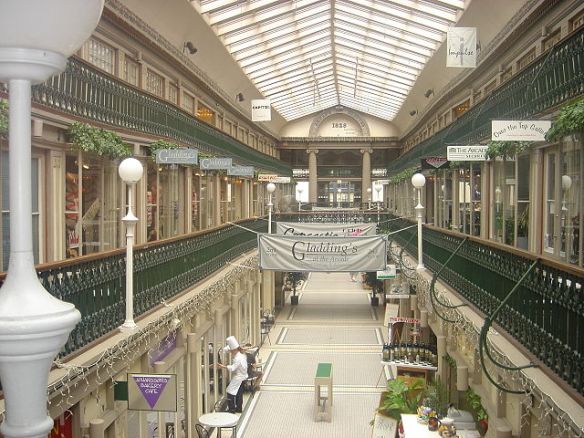
Photo By Loodog at the English language Wikipedia, CC BY-SA 3.0, https://commons.wikimedia.org/w/index.php?curid=16942467
The Westminster Arcade, located in Providence, Rhode Island, is the oldest indoor shopping mall still standing in America and built in 1828. Adapted from the popularity of malls in Europe and England, the Arcade housed three stories of boutiques, merchants, and commercial businesses along a central promenade. The mall was a huge success and the trend of indoor malls continued to grow throughout the United States. The Arcade was renovated several times throughout the 20th century and received landmark status in 1976. However, throughout the 1980s and 90s, the public’s use and interest in the Arcade dwindled, as did the merchants and commercial businesses that remained. In 2005, the property was sold to developer Evan Granoff, who decided to take an innovative approach to revitalizing the historic and iconic downtown building: Micro-apartments.
The first floor of the Arcade is dedicated to small, local businesses and restaurants (no chains allowed), while the second and third floors have been repurposed into micro-dwellings intended as more affordable living options for recent college graduates and busy urban-dwellers. Currently, there is a wait-list of prospective tenants for the micro-units, the most popular being a little over 200 square feet (you can take a tour of the property here). Granoff not only recognized a need for affordable housing in downtown Providence, but he also saw an opportunity to join a movement currently gaining popularity across the country: re-purposing existing structures, such as old shopping malls that have outlived their purpose, while also providing affordable housing and investing in local businesses.

Photo By Nutmegger (talk) – Own work (Nutmegger), Public Domain, https://commons.wikimedia.org/w/index.php?curid=10237479
Re-purposing the space also aligns with Providence’s city-wide plan to increase sustainability and neutralize the city’s carbon footprint by 2050: which includes plans for improved water-usage, more sustainable transportation choices and accessibility, more sustainable land-use, as well as a larger variety of affordable housing options for city-dwellers. The low-tech innovative work accomplished by re-purposing the Arcade is something that could breathe new life into other urban areas as well, especially for buildings that have outlived their purpose yet have achieved landmark status and are therefore protected from being demolished.
Sources:
https://www.providenceri.com/sustainability
http://www.ecori.org/eco-people/2015/6/24/new-sustainability-director-has-plan-for-providence
http://www.govtech.com/fs/US-Cities-Pursue-Creative-Urban-Innovation-Projects.html

This is a really awesome use for the space. I loved how, in the video, they look at a picture from the 1940’s and it showed that even then the upper floors were rarely used for retail space. The use of those floors for apartments seems like it is really simple, but I don’t think many people would have thought to do that. Not only are the apartments cool, but they’re extremely efficient. They help to create a minimalist culture that could help lay the foundation for a society that has a lower carbon footprint because of their desired lifestyle versus altering a lifestyle to attain a low footprint. It sort of lays the ground work for only using what we need and not having so much excess.
LikeLike
Thanks, and glad you liked/watched the video. I was surprised by that picture of the 1940’s as well, I also found it interesting that the smaller apartments were in higher demand than the 400 or 700 sq ft units. Thanks for your comment!
LikeLike
The Arcade is an amazing space that I never even knew existed! To use the empty retail spaces and repurposing them to be small and affordable apartments is something I would have never imagined for an indoor mall. It is a brilliant idea that should be brought to other old buildings throughout the country, instead of demolishing and creating new buildings. In Chicago the Old Chicago Main Post Office was once the largest building in the world and now has been vacant for almost 20 years. It has the potential to contain retail, office space, public green space and apartments all in one. If Chicago was to use the Arcade as an example of how we should renovate these old landmarks instead of tearing down and starting over. In the long run it would save money and preserve history.
http://chicagotonight.wttw.com/2016/08/02/old-main-post-office-troubled-giant-brink-transformation
LikeLike
Thanks, I learned about the space a couple years ago and became obsessed, so I try to spread the word about it every chance I get. There are other examples of malls in more suburban areas being re-purposed and revitalized, but I really love that this project is located in a city and about saving a historic building. It would be awesome to see the old post office transformed into something similar, and I’m excited about this concept gaining traction and spreading to other cities as well! Thanks for your comment.
Here’s some more reading if you’re interested:
http://gizmodo.com/7-dead-shopping-malls-that-found-surprising-second-live-1634073681
http://www.theatlantic.com/business/archive/2015/03/a-new-life-for-dead-malls/387001/
http://www.npr.org/2014/09/10/347132924/heres-whats-becoming-of-americas-dead-shopping-malls
LikeLike
After reading the one answer on my post I was redirected to yours 🙂 Your post is interesting to read. In my opinion, this is a good example of positive development initiated by a private developer. Sadly, these examples are rare. Europe features many examples of business-owner owned malls. They normally organize in cooperatives and structure their organizations in similar ways as employee-owned businesses do. The concept of cooperatives is mostly known for housing, but, as said, is well explored with malls in Europe. Maybe we can even think beyond that and envision cooperative schools or development agencies that engage in some kind of public-semipublic partnership with the local government.
LikeLike